 CLOUD
CLOUD
 CLOUD
CLOUD
 CLOUD
CLOUD
Earnings prints from the likes of Dell Technologies Inc., Super Micro Computer Inc. and more recently Hewlett Packard Enterprise Co. have shown the artificial intelligence server trend is not just benefiting cloud hyperscalers but also firms with large on-premises installed bases.
Oracle Corp. as well is trading at an all-time high, citing cloud momentum and recent deals with Google LLC, OpenAI and prior deals with Microsoft Corp. But make no mistake, the momentum from the big three U.S. hyperscalers remains impressive, especially when considering the size of these firms.
Combined, infrastructure-as-a-service and platform-as-a-service infrastructure revenue for Amazon Web Services Inc., Microsoft Azure and Google Cloud Platform will approach $195 billion this year. Add in Alibaba Group Holding Ltd. and the market will exceed $200 billion and is growing above 20% annually. One notable callout however is Supermicro, which is growing in the triple digits and has put itself directly into the AI server mix.
In this Breaking Analysis and ahead of HPE Discover, we update you on the action in the on-premises and cloud infrastructure markets as AI servers power an AI trade that is extending beyond the four silicon horsemen of Nvidia Corp., Taiwan Semiconductor Manufacturing Corp., Broadcom Inc. and Qualcomm Inc. We also share some recent Enterprise Technology Research spending data and dig deeper into the true size of Microsoft’s Azure IaaS and PaaS revenue.
Let’s start by looking at the market performance of three bellwether on-premises server market leaders – Supermicro, Dell and HPE.
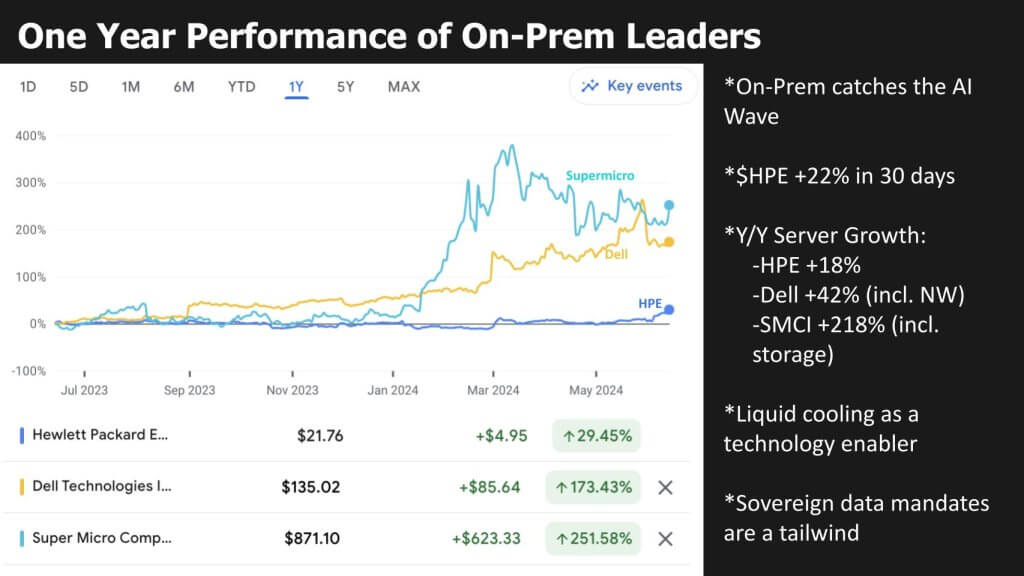
Above we show a 12-month view of the performance of these stocks. Over the past year, they’ve experienced significant gains, reflecting an increased demand for AI servers and related technologies.
The year-on-year server growth for HPE, Dell and Supermicro underscores a meaningful expansion driven by the AI wave. While Dell faces margin concerns, it is strategically positioning itself for future profitability by securing account footprint into which it will sell storage infrastructure, PCs and other services. Supermicro’s exceptional growth, focus on packaging flexibility and cost effectiveness highlight its competitive edge. The demand for sovereign data solutions further strengthens the on-premises server market, making these companies well-positioned for continued success. Each has expressed strong demand and good visibility for the next several quarters.
HPE’s strong recent quarter is reflected in the ETR data shown below.
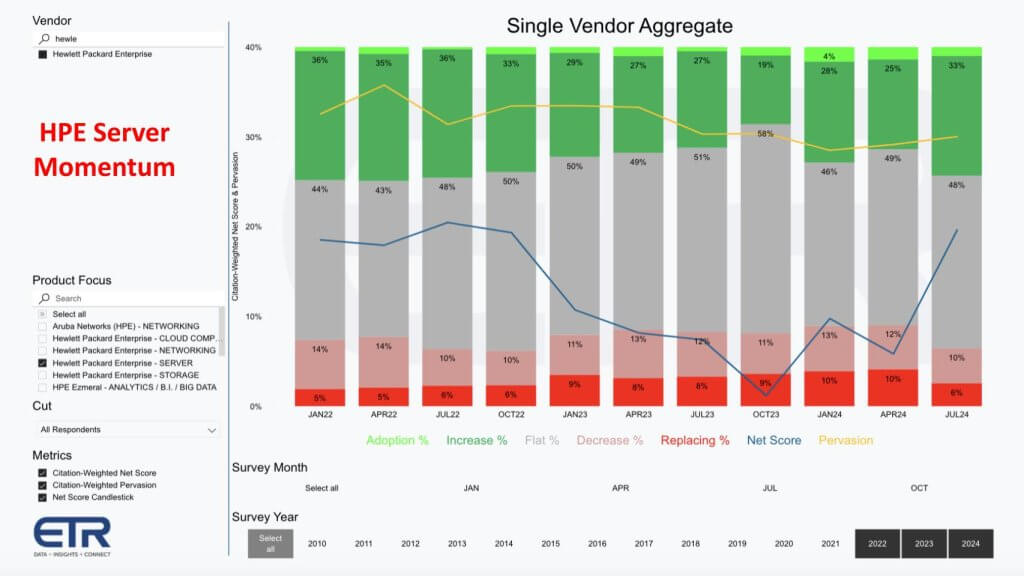
The graphic above breaks down ETR’s proprietary Net Score methodology and provides a detailed analysis of spending patterns for HPE servers (N~120). The methodology is focused on customer/account penetration and doesn’t reflect dollar amounts.
Specifically breaking down the bars shown above:
The ETR data aligns with the positive trends in the market and showcases HPE’s robust performance. The positive trend in Net Score, increase in those customers spending more and reduced churn all indicate strong momentum for HPE servers. Market penetration as well appears to be slowly improving, reflecting HPE’s continued influence in the on-premises server market.
Though the on-premises server market shows strength, we find it instructive to compare these firms with hyperscalers to gain a more comprehensive view of the market. The following analysis compares the recent quarterly data for Dell, HPE, Supermicro, AWS, Microsoft Azure and GCP to provide a benchmark, highlighting their growth rates, revenue projections, valuations and operating profits.
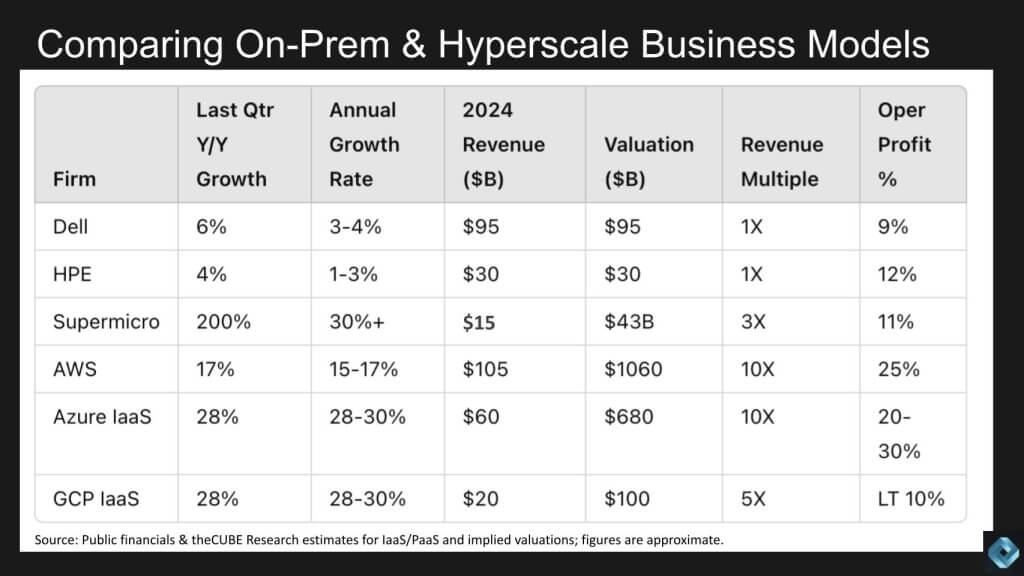
The data above was compiled using a combination of publicly available financial data, theCUBE Research market modeling and inferred valuations based on reasonably educated estimates. The data are approximate and intended to be used for rough comparative purposes.
Comparing the on-premises server leaders with hyperscalers reveals a meaningful contrasts in business models and growth trajectories, Supermicro notwithstanding. Supermicro’s extraordinary growth and differentiated business model is something we’re watching as an indicator of on-prem dynamics. Nonetheless, the hyperscalers remain leading players with a combination of massive capital spending investments, AI optionality and excellence and vibrant developer/third-party ecosystems.
Assessing hyperscale infrastructure on an apples-to-apples basis is always a challenge. Though AWS created the market and reports on its business performance, it continues to evolve beyond compute, storage and networking services. It offers up-the-stack services in database and data services, AI tooling such as SageMaker, on-premises infrastructure such as Outposts and now applications such as Q and other services (for example, call center). These nuances make it difficult to not only track AWS’ clean IaaS and PaaS figures, but trying to compare AWS’ business model with Azure and GCP further complicates matters.
Below we attempt to do so.
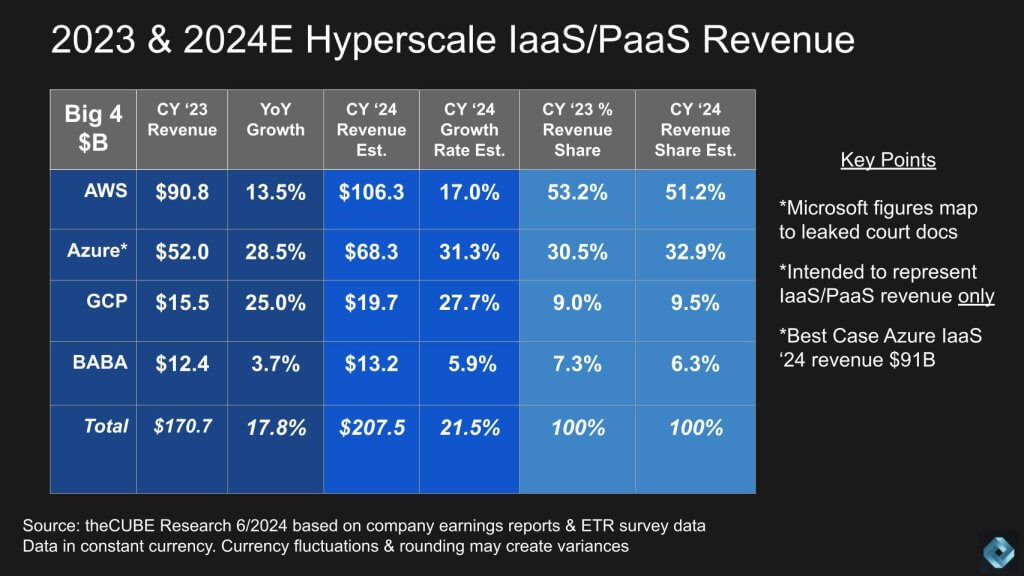
Above we examine theCUBE Research’s revenue estimates for the big four hyperscalers — AWS, Azure, GCP and Alibaba.
Note: We attempt to adjust all estimates to constant currency.
The hyperscaler market, driven by AWS, Azure, GCP and Alibaba, is poised for substantial growth, accelerated by the AI trend. AWS continues to dominate with over 50% market share, while Azure’s revenue estimates vary significantly based on different modeling approaches. These projections speak to the dynamic nature of the hyperscaler market and the critical role of AI in shaping its future trajectory.
Unpacking Microsoft’s Azure numbers is part art, part science. Relying on Microsoft’s public statements about Azure growth is what most pundits and analysts do, but comparing them on an apples-to-apples basis with AWS and GCP is not so straightforward. As such, we maintain two models for Azure to reflect best-case/worst-case scenarios.
The following analysis explains in greater detail how we approach this problem. It examines Microsoft’s internal documents, leaked during the Activision trial, focusing on Azure’s infrastructure revenue with statements comparing Azure to AWS and Google Cloud. The data below provides a more detailed comparison of the reported and estimated revenues, highlighting the differences between pure infrastructure (IaaS and PaaS) and broader metrics.
The screenshot shown below is instructive and was first reported by The Information a year ago. TheCUBE Research subsequently made attempts to dig further into the data and adjust its market numbers accordingly.
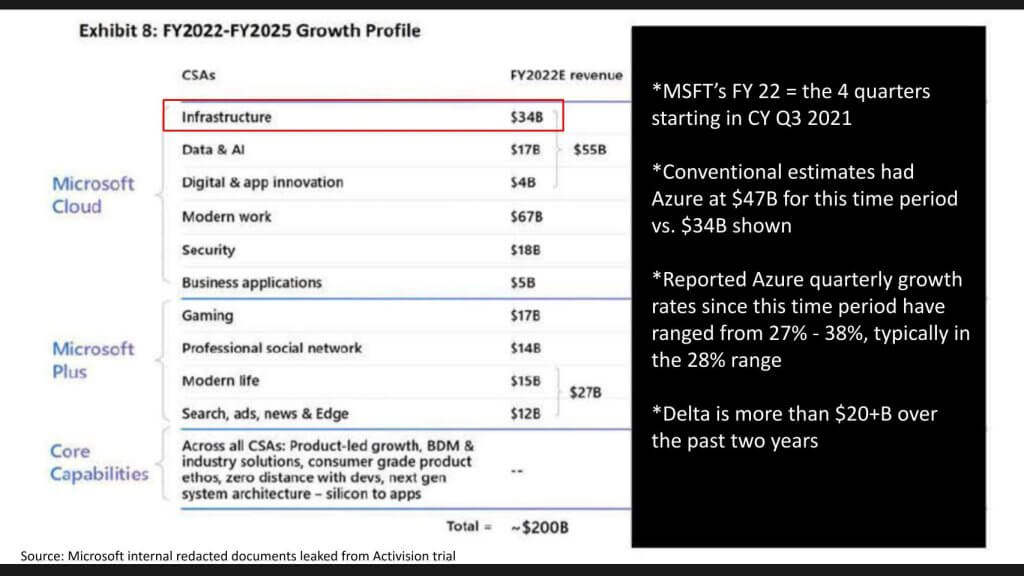
TheCUBE Research team reassessed its model for Azure and revised its projections to fit the $34 billion figure within the four quarters indicated. The problem is that it deviates from certain public statements that Microsoft has made regarding Azure. As such, our assessment is that Azure, as reported by Microsoft, includes items other than IaaS/PaaS infrastructure and is not directly comparable to AWS’ revenue figures.
Below we put our two models in context relative to AWS’ reported revenue for the years 2022 and 2023 and our estimates for 2024.
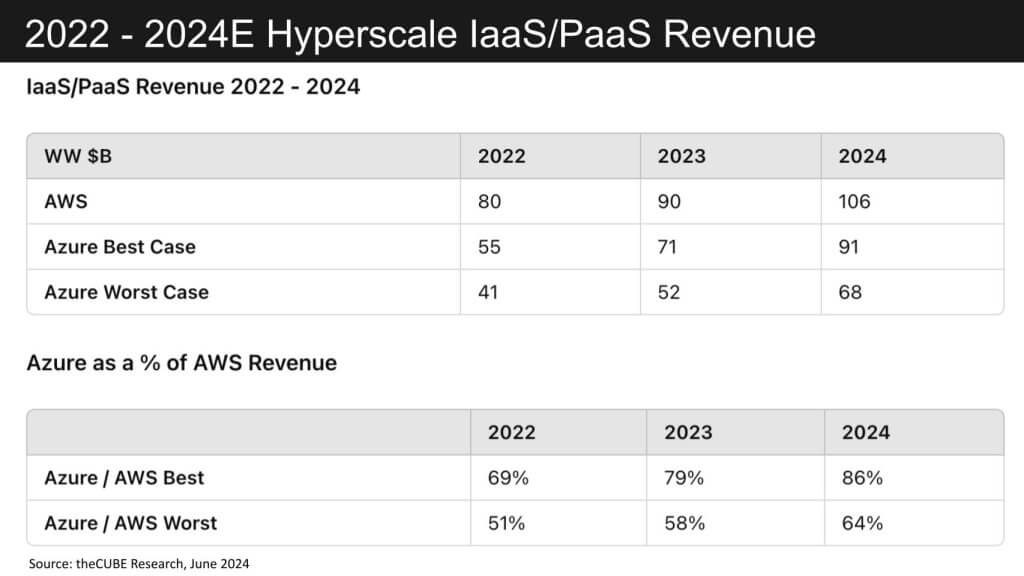
The reported annual and quarterly growth rates for Azure and AWS highlight significant differences in revenue estimates, underscoring the complexity of comparing cloud infrastructure providers.
Financial definitions from Microsoft’s 10-Ks provide some guidance but remain fuzzy. The following is from the company’s most recent 10-K:
Azure is a comprehensive set of cloud services that offer developers, IT professionals, and enterprises freedom to build, deploy, and manage applications on any platform or device. Customers can use Azure through our global network of datacenters for computing, networking, storage, mobile and web application services, AI, IoT, cognitive services, and machine learning. Azure enables customers to devote more resources to development and use of applications that benefit their organizations, rather than managing on-premises hardware and software. Azure revenue is mainly affected by infrastructure-as-a-service and platform-as-a-service consumption-based services, and per user-based services such as Enterprise Mobility + Security.
While helpful, the above definitions remain opaque. The comparative analysis of AWS and Azure revenues from 2022 to 2024 shows significant disparities depending on the modeling approach. While AWS maintains a strong position with clear IaaS and PaaS revenue streams, Azure’s broader inclusion of hybrid and on-prem components complicates direct comparisons. The best-case and worst-case models for Azure demonstrate a wide range in revenue estimates, highlighting the need for careful interpretation of financial data in understanding the true market positions of these cloud giants.
Let’s take a look at the ETR data from the April survey and provide some clues for the survey that’s currently in the field.
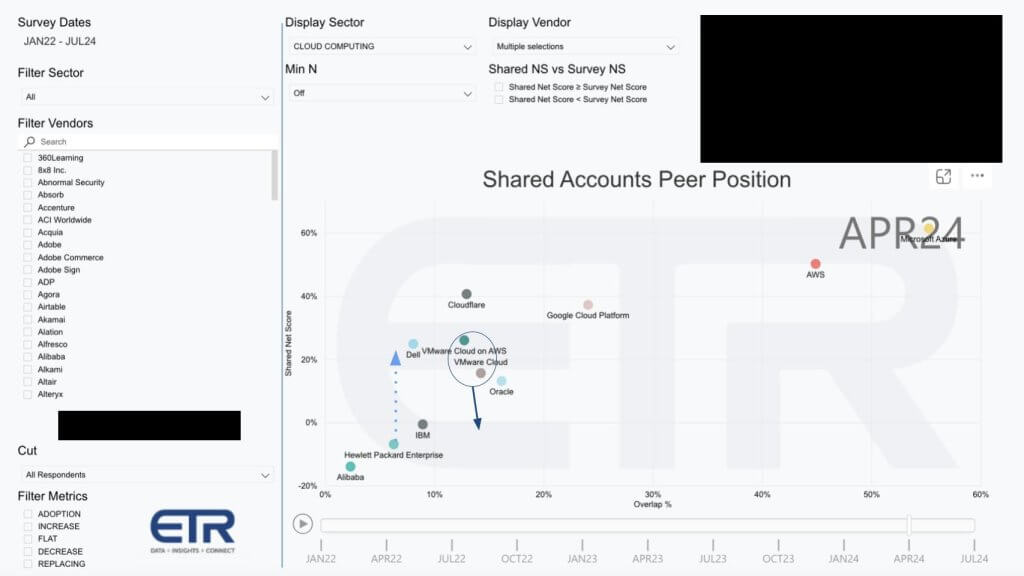
The ETR data above provides insights into the spending momentum and market penetration of various companies in the cloud computing sector. This analysis, based on the April survey, offers a snapshot of customer spending trends and market positioning, with redacted data from the July survey, which is currently in the field.
The ETR data highlights the strong spending momentum and market penetration of leading cloud providers, particularly Microsoft and AWS. The glimpse into the upcoming survey suggests a significant move by HPE. This view of the market underscores the dynamic nature of the cloud computing sector, with shifts in customer spending and strategic positioning shaping the competitive landscape.
As we look toward the remainder of 2024 and beyond, the visibility on AI server growth and storage demand for companies like HPE, Dell and Supermicro is exceptionally strong. In addition, the ETR data shows improved momentum in storage, which is poised to boost these companies significantly thanks to higher gross margins in storage.
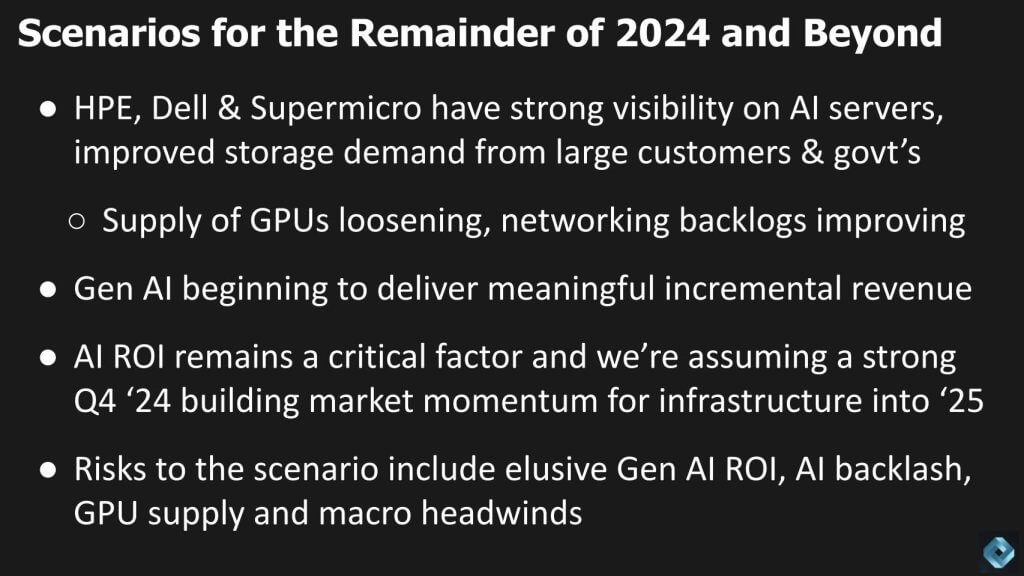
Looking ahead, AI server growth and storage demand provide a robust outlook for HPE, Dell and Supermicro, supported by stronger gross margins. The hybrid cloud story remains relevant but is outpaced by cloud computing growth rates. Sovereign cloud demand and AI ROI will be critical factors moving forward. The upcoming HPE Discover event will shed more light on these trends and their implications for the industry.
Tune in for more updates and insights from our coverage on siliconangle.com and thecube.net.
What’s your call for 2024 and beyond? Will on-prem momentum continue into 2025 for AI servers? Can Supermicro maintain triple digit growth rates? Will cloud players’ growth rates continue to stay at current levels or will they decelerate? Or will AI provide a tailwind that accelerates their growth rates?
Support our open free content by sharing and engaging with our content and community.
Where Technology Leaders Connect, Share Intelligence & Create Opportunities
SiliconANGLE Media is a recognized leader in digital media innovation serving innovative audiences and brands, bringing together cutting-edge technology, influential content, strategic insights and real-time audience engagement. As the parent company of SiliconANGLE, theCUBE Network, theCUBE Research, CUBE365, theCUBE AI and theCUBE SuperStudios — such as those established in Silicon Valley and the New York Stock Exchange (NYSE) — SiliconANGLE Media operates at the intersection of media, technology, and AI. .
Founded by tech visionaries John Furrier and Dave Vellante, SiliconANGLE Media has built a powerful ecosystem of industry-leading digital media brands, with a reach of 15+ million elite tech professionals. The company’s new, proprietary theCUBE AI Video cloud is breaking ground in audience interaction, leveraging theCUBEai.com neural network to help technology companies make data-driven decisions and stay at the forefront of industry conversations.